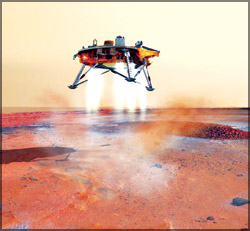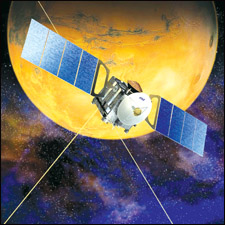Phoenix on Mars?
 Mars
has always been one of those planets which fascinated many, especially
children, with stories of extraterrestrial life. Recall how you stared
out of your windows at night, hoping to see little Martians come down to
Earth on a flying saucer to play with you? Well, today various space
programmes are under way, to check on Mars
has always been one of those planets which fascinated many, especially
children, with stories of extraterrestrial life. Recall how you stared
out of your windows at night, hoping to see little Martians come down to
Earth on a flying saucer to play with you? Well, today various space
programmes are under way, to check on the possibility of life in Mars, and specially the existence of water.
the possibility of life in Mars, and specially the existence of water.
The European Space Agency (ESA) has taken a step to explore the
unknowns of Mars, and it came up with the Mars Express mission. This was
followed by a mission called Mission Phoenix by NASA, which is the
hottest topic in the field of astronomy these days. Let's look at these
two missions and see if your expectations of seeing a Martian in your
backyard will ever become a reality.
Phoenix Lander
Phoenix is a robotic spacecraft on a space exploration mission to
Mars which is the most recent spacecraft which left Earth on a long
journey towards the Red Planet.
The scientists conducting the mission will use instruments aboard the
Phoenix Lander to search for environments suitable for microbial life on
Mars, and to research the history of water there, which has been a
highly discussed topic lately. Phoenix was launched successfully on
August 4, 2007 from its launch pad at Cape Canaveral Air Force Base, and
it is scheduled to land on Mars on May 25, 2008.
An important thing about the mission is that the University of
Arizona was honoured to be the first public university to lead a mission
to Mars, and it has taken part in creating many instruments of the
Phoenix Lander.
The critical part of the descent lasts about 13 minutes. During this
time, the probe will transmit a continuous stream of information to two of NASA's satellites already orbiting the
Red Planet, while being monitored by the 'Mars Express'.
stream of information to two of NASA's satellites already orbiting the
Red Planet, while being monitored by the 'Mars Express'.
Instruments of Phoenix
On board the Phoenix are a set of sophisticated instruments to engage
on various tests. Let's look at a few of them, and their main
functionalities.
* Robotic Arm
The Robotic Arm on the Phoenix is designed to extend 2.35m from its
base on the lander, and have the ability to dig down to half a metre
below the surface. It will take samples of dirt and water-ice that will
be analyzed by other instruments on the Lander.
* Robotic Arm Camera
The Robotic Arm Camera attached to the Robotic Arm just above the
scoop is able to take full-colour pictures of the area.
* Thermal and Evolved Gas Analyser
Thermal and Evolved Gas Analyser, or TEGA, is a combination of a
high-temperature furnace with a mass spectrometer. It will be used to
bake samples of Martian dust, and determine the content of this dust.

* Mars Descent Imager
The Mars Descent Imager, or MARDI, will be used to take a picture of
the Martian soil as the Lander descends.
* Meteorological Station
The Meteorological Station, or MET, will record the daily weather
during the course of the Phoenix Mission. It is equipped with a variety
of temperature and pressure sensors to do so. It is also test for the
amount and number of dust particles in the air.
The Phoenix DVD
In fact, it was not just scientific equipment that went on board the
Phoenix. Attached to the deck of the Lander is 'The Phoenix DVD',
compiled by the Planetary Society. The disc contains 'Visions of Mars',
a multimedia collection of literature and art about the Red Planet.
Towards the last quarter of 2006, the Planetary Society collected a
quarter million names submitted through the internet and placed them on
the disc, which is said to be 'the first library on Mars'. This was
mentioned through 'Space station', and we hope that you added your
information to be carried on this legendary DVD.
The Phoenix DVD is made of a special silica glass designed to
withstand the Martian environment, lasting for hundreds of years on the
surface till it is discovered.
Mars Express
This is the first interplanetary mission carried out by the European
Space Agency. Let’s focus on the name of this mission. The part ‘Mars’
is obvious, since it was a mission regarding Mars.
The part ‘Express’ was added because the designing and the
construction was done in rather a hurry and ‘Express’ also describes the
spacecraft’s relatively short interplanetary voyage, which resulted as
being launched when the orbits of Earth and Mars brought them closer
than ever before in about 60,000 years.
The ‘Mars Express’ consisted of two parts, namely the Mars Express
Orbiter and the Beagle. The Orbiter was to orbit Mars and investigate at
a distance, whereas Beagle was a lander which was arranged to perform
tests on the Martian surface. Unfortunately, the Beagle landing did not
turn out successfully. But, the Mars Express orbiter has been sending
results of important measurements since early 2004.
The Mars Express will keep an eye on NASA’s Phoenix Lander as it
reaches the Martian surface, according to a request made by NASA to the
ESA to monitor the Phoenix’s Entry Descent and Landing (EDL) stage. This
is a good example of international cooperation and interplanetary
networking.
Aravinda Dassanayake |
